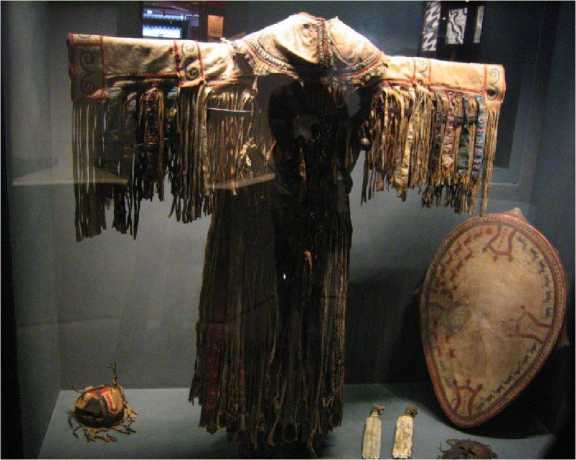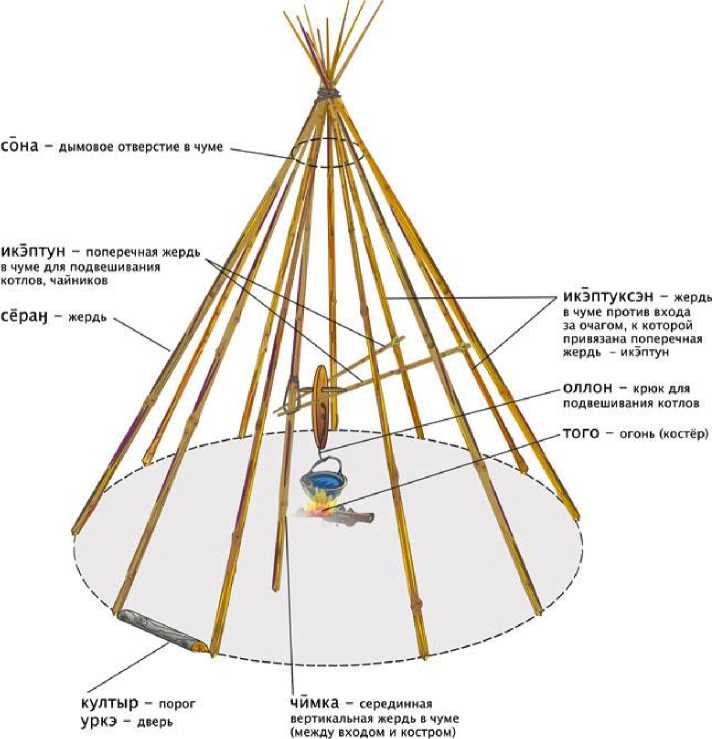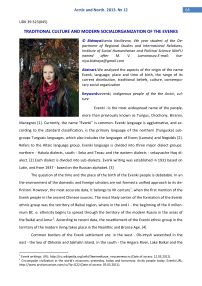Traditional culture and modern social organization of the evenks
Автор: Bidnaya K.V.
Журнал: Arctic and North @arctic-and-north
Рубрика: Indigenous people of the Arctic and North
Статья в выпуске: 12, 2013 года.
Бесплатный доступ
We analyzed the aspects of the origin of the name Evenk, language, place and time of birth, the range of its current distribution, traditional beliefs, culture, contemporary social organization.
Evenki, indigenous people of the the Arctic, culture
Короткий адрес: https://sciup.org/148319910
IDR: 148319910 | УДК: 39:323(045)
Текст научной статьи Traditional culture and modern social organization of the evenks
Evenki –is the most widespread name of the people, more than previously known as Tungus, Orochony, Birarov,
Manegrov [1]. Currently, the name "Evenki" is common. Evenki language is agglutinative, and according to the standard classification, is the primary language of the northern (Tunguska) subgroups Tungusic languages, which also includes the languages of Evens (Lamuts) and Negidals [2]. Refers to the Altaic language group. Evenki language is divided into three major dialect groups: northern - Hakala dialects, south - Seka and Tecau and the eastern dialects - sekayusche Haq dialect. [2] Each dialect is divided into sub-dialects. Evenk writing was established in 1931 based on Latin, and from 1937 - based on the Russian alphabet. [3]
The question of the time and the place of the birth of the Evenki people is debatable. In an the environment of the domestic and foreign scholars are not formed a unified approach to its definition. However, the most accurate data, it belongs to VII century1, when the first mention of the Evenk people in the ancient Chinese sources. The most likely center of the formation of the Evenki ethnic group was the territory of Baikal region, where in the end I - the beginning of the II millennium BC. e. ethnicity begins to spread through the territory of the modern Russia in the areas of the Baikal and Amur2. According to recent data, the resettlement of the Evenki ethnic group in the territory of the modern living takes place in the Neolithic and Bronze Age. [4]
Common borders of the Evenk settlement are: in the west - Ob-Irtysh watershed in the east - the Sea of Okhotsk and Sakhalin Island, in the south - the Angara River, Lake Baikal and the
Amur River - in the north. [1] In the north, bordering the Evens Evenki, Yakut, Dolgan, Nenets. In addition, the Evenki live in priakticheskoy area, so I think the indigenous people of the Arctic. Overall size of the territory occupied by the Evenki is difficult to determine, it is estimated about one-quarter of the territory of Siberia and the Far East (2 ½ - 3 million sq. km.). A characteristic feature in the resettlement of the Evenki - dispersion.
Traditional beliefs Evenki - animism, shamanism, magic, fishing and ancestral cults, the cult of the ancestors - remain in some places still. According to the pagan beliefs of the Evenk, the universe exists in the form of seven worlds: the three heavenly, the middle world - land and three underground, united by a central pillar. [1]
Along with that existed and the notion of the three worlds, connected by a river of the world. Firmament imagined land of the upper world, where herds of deer, deer skin or inverted pot. Sign pointing to the upper world the North Star in the lower - crevice caves, whirlpools [1]. Top of the world inhabited by the ancestors of the people, the supreme deity, the owners of the phenomena of the nature and the elements: sun, moon, thunder and wind. The presiding deity -the spirit of the sky, the owner of the upper world - the old man Hamaca, the holder of threads of life, steward their lives. Deity of the sun in one group was considered an old man Delic, others -old Enekan - Sigong. They were the masters of light and heat: The sun in the sky tent kopilo heat from it depended on the change of the seasons. Spirits of the middle world - Dulu, Boke - the owners of tribal territories of individual sites, mountains, taiga, water, homemade spirits who guard. The lower world is inhabited by the spirits of the dead, the spirits of disease, the evil spirits [1].
In addition, a large spread among the Evenki was cults of the animals. They are connected with totemism as well as with the fishing rituals, in some cases, this syncretic cult that has arisen on the basis of the different forms of the religion, and the fear of the formidable predators, such as bear, wolf. The highly Evenki have been developed cult of the bear. Bear is such a person. He understands human speech, can be converted into a human and back. Bear, if you speak ill of him, laugh at him or threaten to, could take revenge. Therefore it is necessary to behave prudently. Going on a hunt, said metaphorically: "You have to hunt down the beast." Before you kill a bear in a den, his wake. Evenki, going to the den and said: "Grandpa, you kill crows" or "Do not you come to the Tungus and Yakut" (ie, someone else's). Sometimes, to deflect the blame, portrayed raven povoroni shouted, waving his arms like wings. Evenki, killing the bear, asked for forgiveness, was withdrawn from the blame. [1] Also, the Evenki sacred birds, helpers of shamans were considered cranes. They are not allowed to kill.
Equally it a cult of the sacred plants and objects. Evenki endowed soul appearance a little man or birds that are in the head, the hair. Soul, as bearer of life, Evenki sometimes endowed not only rights, but also objects and phenomena of the nature that can show signs of the life: movement, growth, breathing (animals, plants, rocks, wind, etc.). Thus, the Evenki soul plants - is its lifeblood, which are located inside the trunk of a tree and its roots. Evenki honored some larch and Labrador tea, a young willow and dwarf birch. [1]
The personification of Nature has been a source of the formation of the images of the spiritual masters of the nature - mountains, lakes, rivers, seas, mother earth, sky, planets, constellations, thunderstorms, lightning, wind, etc. belong to a special category of the domestic spirits - spirits of fire, hearth, and the evil spirits. Also, the Evenki was known special worship of fire. It was believed that the fire has purifying force. They believed that the spirits of the fire live his host - the old man and an old woman, and their children, on which the prosperity of the house and good luck in the field.
The fire was considered as a mediator between the human world and the world of the ancestral spirits of the universe, so he had been approached in the different life situations. Focus function - heating and lighting homes, cooking, protection from wild animals, and others - led to a special relationship to him as the sacred center of the home. Fire - the main family shrine - is widely used in family rituals. Fireside constantly sought to maintain. During migrations Evenki transported it to the pot. Handling the fire passed from generation to generation. Hearth fire took care of the defilement, not throw it in the trash, cones ("not to close up grandma resin eyes" - Evenki), anything sharp to touch the fire, pour water into it. [5] Honoring the fire and passed on the items that have sustained contact with him - hook over the hearth, stove, some utensils. Evenki considered fire a living thing that has soul3.
The cult of fire is closely connected with the worship of the spirits. As they see it, ancestors learned to deal with the fire spirits hosts. Therefore, the fire appeared "mediator" between humans and gods, spirits. In Evenki fire could transmit information mistress taiga, spiritual masters taiga area and influence future events. Before fishing Evenki "consulted" with fire: in response to their thoughts or words blaze bonfire burn evenly, it boded good luck. Flight direction indicated spark hunter desired path. The sharp crackling or hissing fire foreshadowed failure, and then set aside a hunter out to fish. The fire could have predicted the imminent arrival of the guests. When guessing on the road ahead, close fate fire "devil" on the blade of a deer roads individual or family.
The fire had cleansing properties, could destroy or drive out evil spirits, so used for medicinal and shamanistic rituals. Over the fire, "purified" fishing gear during long hunting failure. Going through a campfire cleared the mourners. The cult of fire is inseparable from the cult of the ancestors4.
Evenki had the classical forms of the shamanism (the word "shaman" - Evenk-parameter). Shaman, an intermediary between the people and the spirits in the form of an animal or an ancestor of his spirit flies in the worlds of the universe, trying to cure diseases, to find the missing, to know the future, to ensure a good crop of animals, birth of a child or to help carry the dead to the world of the soul of the deceased [5 ]. For this purpose he had a spirit-helpers, figures are carved from wood, made of iron and fur. Each had its own shaman River - a tributary of the main river shaman, where it remained spirit-helpers, when he did not give them orders.
The important role played shamanic attributes: costume with pendants and drawings, steel crown with deer antlers ancestor, tambourine, clapper, staff, harnesses snake, symbolizing the shaman of the road, etc. The man in the traditional views, had a few souls, and they all require care and food: the mind-body in the shape of the birds, the soul-life - breath, blood, etc., the soulshadow - double, the image [3].

Pic. 1. Evenk shaman's
The disease was considered the result of an evil spirit who stole one of the shower or got inside the patient's body. Therefore, the shaman had to get out of the spirit of the body or to take away his soul sick. Evenk shaman was considered the strongest in Siberia, have resorted to using their neighboring nations. [4]
In the XVI - XVII centuries began the treatment to Christianity of Evenks. At the end of the XIX century almost all were considered Orthodox, although some groups have been influenced by Lamaism5. However, Christianity was limited to the Evenki formal execution rites of the Orthodox Church, which is usually held in the conjunction for the arrival of the priest in the taiga. In this case, the images of the saints of the Orthodox religion intertwined with ancient ideas about spirits. [2] Today Evenki one of the most Christianized peoples of the north, aided by active missionary work. In the places of their settlement were built Orthodox churches and chapels. Already in the 50's of the nineteenth century, Popov published in Evenki prayers, gospel and church-based primer on [3]. Christianity covers almost all the aspects of the life in the Evenki.
In some areas, local radio is transmitting. In the Evenk Autonomous Okrug once a week there is a supplement to the district newspaper. Great job on the revival of the native language are ZN Pikunova, the main author of the study guides. In the Sakha-Yakutia known is specialized Evenki school in the village of Yengri.

Pic. 2. Chum of Evenks (scheme).URL:
ThesocialorganizationofthesocietyofthemodernEvenks speaks to their extremely strong integration among the Russian population. "Endemic unemployment, loss of life choices and as a result of all this alcohol and marginalization were common scourges of life Evenk Russian." It is no accident that today there is a steady downward trend in natural increase of population in the Evenk Russia. Continuing increase in the incidence of Evenk since medico-geographical conditions in are extremely uncomfortable for the people living areas, and medical care is virtually nonexistent. It is also worth noting that today Evenki fully integrated into the regional community.
The degradation of the traditional economy, curtailing production infrastructure in the national villages extremely heightened ethnic and social situation in the areas inhabited by the Evenki. The most painful is the problem of the unemployment.
Evenki before 1 January 2007 had their own national-territorial formation. Evenk Autonomous District, created in 1930, was transformed into the Evenk district of the Krasnoyarsk Territory. Today, the structure of the regional and territorial governments is committees and the management for the indigenous people in the district administrations involved in their problems usually one person.
In the recent years an increasing role in the organization of the national life began to play a social organization. Powerful impetus to the social movement of the Evenk population gave the first congress (Big Suglan) Evenk Russia, which took place in 1993 in the administrative center of the Evenk Autonomous Okrug settlement Tour. [3] In the Congress adopted the Declaration outlines the main directions of the national revival of the people on the basis of the self-organization and self-management. After the Congress has accelerated the establishment of the associations, cultural associations, and various forms of the national and cultural autonomy, which are now operating in all the areas inhabited by the Evenki. They are in contact with the regional authorities are involved in the preparation of the legal instruments, some of them have the right of legislative initiative. In all regions, the association (Amur Region, Chita region, Buryatia, Krasnoyarsk Territory, and others) are trying to actively influence the authorities to improve the current situation. In other regions, the Evenki are also represented in the public institutions. In 2000 he also established the Youth League Evenki, which may help the younger generation to continue the rich tradition of the Evenk people. [1]
In the recent years become an annual traditional big Suglan on which to discuss the pressing issues of the ethnic life together representatives of all regional groups of Evenki. It is worth noting that in the Evenk Autonomous District from 1994 to 2007 there was national legislature -Suglan.
With the worsening socio-economic problems are closely related to the psychological problems. Evenk population is stung by the lack of the proper attention to their concerns on the part of the public authorities, both federal and local governments. But along with this it is worth noting the extreme passivity of the Evenki against the government. The most important problem is the problem of the lack of proper legal regulation of the status of indigenous aboriginal people.
Since the Evenki settled in the different administrative bodies against them have different legislation passed subjects of the Russian Federation. In most areas are covered by the general legislation on the indigenous minorities of the North. The exception is the Republic of Buryatia, the law that there is a law specifically devoted Evenki, - "On the legal status of the Evenki village (township) of the Soviets of People's Deputies," adopted in October 1991 special article that takes into account the interests of the compact living of the Evenk population, is also contained in Law "On the languages of the Republic of Buryatia" (1992). The Law "On hunting and farming" (1993) reflects the priority right to allocate them to the Evenki hunting grounds. Important for the life of Evenk community can be considered as the Forest Code of the Irkutsk Region (1995), establishes a special procedure for their forest management, the laws of the Republic of Sakha (Yakutia) "On Reindeer" and "On the hunt", the Law "On the community of Indigenous Peoples of the North" in Khabarovsk Territory (1996). There are no laws regulating the legal relations of Evenks i n the Chita and Amur regions[3].
Список литературы Traditional culture and modern social organization of the evenks
- Association of Indigenous People of the North. URL: http://raipon.info/narody narodysevera- sibiri-i-dalnego-vostoka-rf/295-2009-08-31-14-43-03.html; http://www. narodsevera. ru / north / narod / evek (date of access: 2.03.2012).
- The people of Siberia / ed. A. Levin, L. M. Potapov. Moscow: Academy of Sciences, 1956. 1083 p
- The people of Russia. Atlas of the cultures and religions / ed. EP Batyanova, LA Bahmatskoy, I. Vlasova. Moscow: Design. Information. Cartography, 2009. 319p.
- The Arctic –is my home. The people of the North of the Earth. The Culture of the people of the North / Ed. ZP Sokolova. Moscow: Northern expanses, 2001. 284 p.
- Boreyko VE Forest folklore. The tree of life, and sacred groves. URL: http://www.litmir.net/br/?b=129239&p=7 (date of access: 18.04.2012).


